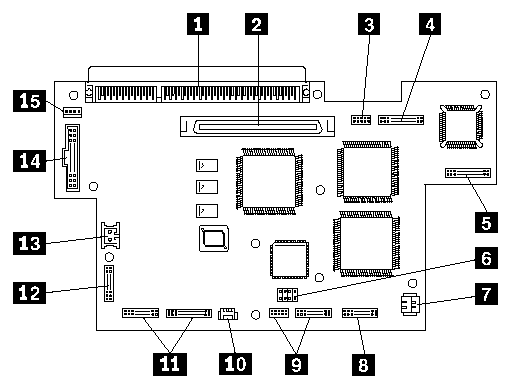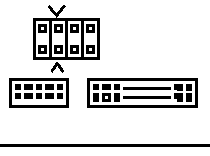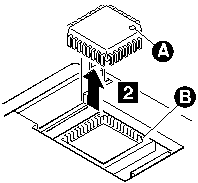|
192-073 IBM PS/2 Model CL57 SX System And Features (8554-045) ZG92-0165 IBM PS/2 Model CL57 SX System 8554-A45 and Features SHS10G4419 IBM PS/2 Model CL57 SX HMR SHS10G4420 IBM PS/2 Model CL57 SX HMS 8554_HMM 8554 Section of TPVOL1.PDF 8554 Power 8554 Numeric Error Codes 8554 Planar
Have something to add? Contact ME
8554 Planar 07G1371 
Memory Peter rains on my parade: The standard 2MB that each CL57 comes with is a 2MB / 72-pin SIMM 80nS (similar to those from a 20MHz 8570) in a socket on the rear side of the planar.I think it is the very same silly Low-Power CMOS chips that the L40SX used. Back then I'd tried to use a bigger / other module but all attempts ended in 2MB useable, no matter what I'd tried. I think the BIOS has just the one 2MB type included and nothing else. Memory expansion is done solely with these JEIDA cards. IBM IC DRAM Cards
Peter blows smoke by saying:
8MB Memory Cards
The CL57 has a minimum of 2MB installed. You can use 2,4 and 8MB IC DRAM cards to expand the memory. However, only 16MB is useable. If you use two 8MB IC DRAM cards, the system will only use 16MB. Action on Memory Error
Clear Password 
Power off system Remove KB and top cover Install jumper over identified pins Power on, leave jumper on until POST ends. Power down and remove jumper. NOTE: Unlike later systems, you
must remove the jumper after clearing the password, or you cannot set a
new power on password. Although that might not be too bad after all.
LCD Peter leads off with: 10.4-inch Thin Film Transistor (TFT) Color LCD with 640 by 480 Video Graphic Array (VGA) resolution. Simultaneous LCD and CRT (eight dots) display is supported. The VGA with LCD controller supports a max of 720x400 (external display) or 640x480 (LCD) in text mode, and 640x480 (both external and LCD) in graphics mode. The VGA with LCD controller is capable of displaying 256 colors at once. Composite video is not supported. If the display has a permanent vertical red line when powered on, it's probably a fine-short within the displays' driver section. These displays were known for "solder beads contamination". The CL57SX has a three-color "I" (red) "B" (green) "M" (blue) badge.
Nice.
Keyboard Peter says: The keyboard is made by Lexmark - as is the keyboard / trackpoint controller board. It is a typical membrane keyboard but time takes its toll. There are two permanent enemies of these type of keyboards: oxydation and detoriation. The plastic stuff gets brittle and breaks. Simply put it is what happened with both keyboards. The connectors aren't that easy to install anyway and are permanently bended. The stuff is like thin glass after 10+ years and the cracks go through the printed conductors as well. Ooof. I'm working on a solution. No easy fix I'd say. However: taking the layers apart is fairly easy. Just remove the keyboard from the machine, remove the metal fixing "rod" from it, turn it over and use a flatblade screwdrive on the plastic hook in the center of the underside. With it pressed back you should be able to slide the metal shield sideways and pull it off. You end up with 5 separate parts:
On inspection with an ohmmeter you find the failing connections measuring from the key contacts towards the connector ends. I detected no less than 3 missing links, all within the small part that connect the keyboard to the controller board. The membrane area itself is in good condition on both sheets. Beware: the printed conducts on the plastic aren't very rigid. Trying to use a glassfibre pen or sharper pencil eraser to clean them from oxydated parts will erode them entirely ! My idea is to connect a thin flat-ribbon cable to the membrane connectors with some sort of conductive glue. Then build some sort of "flat connector" that fits inside the keyboard controller board connectors. Or remove that crap at all and use some angled pinrow connector. Hmmm. Nothing for the faint at heart or people thet tend to get nervous very fast. I wish I had kept the conductive silver paint I used to repair defoggers
on rear windows in my old cars ... must have thrown it away a decade ago.
HDs for 8554 Peter Wendt wrote: The CL57 normally uses an 80MB drive (FRU 95F4708) and this drive is also used in the N51SX / SLC (8551), if it hasn't got only the 40MB drive (FRU 95F4707). For a larger disk for your CL57 or N51, look for the Thinkpad 720/C 120 or 160 MB drives - however it appears as if the 240MB needs a modified systemboard -by what reasons, it is probably an IDE-drive and not ESDI. System Status Indicators 
Note: The Battery Status indicator does not turn on unless there is a battery installed. IBM PS/2 Communications Cartridge II P/N 07G3970 o External expansion port provides connectivity to host and LAN systems via the Communications Cartridge II that can accommodate 3270, 5250 emulation and Token-Ring half-size adapters. The Communications Cartridge II uses a quick attach/detach mechanism for connecting to the CL57 SX and requires no external power source. IBM PS/2 Serial Adapter P/N 79F6800 IBM PS/2 Internal Data/Fax Modem P/N 94X2555 o The IBM PS/2 Internal Data/Fax Modem and IBM PS/2 Serial Adapter optional features use the same internal connector, so only one of these options can be installed per system. IBM High Speed Internal Data/Fax Modem (P/N 42G2580) is a V.32bis Data
(300-14,400bps)/V.17 fax (300-14,400bps), internal modem. 192-261
Install Math Co-Processor
Ingenious, carefully lift the small plate (right-hand or FDD side at the corner on the bottom) with a screwdriver. It pops up and reveals the socket. Insert the tip of the screwdriver in the lid of the plate, start sideways. Trackball The machine came with a defective trackball - the "pickup rollers" on the sensors were missing. I replaced them with cut-off pieces from a wire insulation (silicon cable - 0.75mm inner diameter). Works fine now. The trackballs suffer on several mechanical problems. The little "sensor wheels" are pretty instable and if you treated that thing a bit too hard the thin printboard carrying the sensors (photo-couplers) will break off from the holders. The upper cover, fixing the ball, needs to be set precisely and may not apply any kind of mechanical stress to the ball itself. The "inner" sides of the sensor-wheel axles are hanging free and the opposite site sits into some sort of plastic holder ... it seems as if they wear out after some time and the further guiding of the axles in no longer given. This results in a trackball that works perfectly left and right, but no longer up and down. I'd tried to fix the problem, but had to time to experiment nay further. The mechanical part of the trackball might be used from some later Compaq laptops - or might be purchased from ALPS (if I remember right). IBM PS/2 Miniature Mouse P/N 07G0033
CL57 Origins Peter wrote: The CL57 was originally a design for domestic japanese / asian markets. IBM had created the L40SX some time before as a cooperative production between IBM Japan and the PS/2 division in Boca Raton. Logically this caused a lot trouble (for example due to different working times and time zones). When the L40 appeared on the market as a Notebook ... the competitors had already announced Laptops - and color LCDs. The IBM Japan development group had built a color laptop "just for fun" and presented it to the IBM Management. They had planned to install the 486SX-processor in the machine - but IBM management was afraid this were a too big competition to the PS/2 series. They gave the okay to bring out the machine but only with a smaller processor ... and so they changed it to have a 386SX. If you look closer into the machines identification you will find a naming "PS/55" - this is typical for originally IBM Japan products, which usually have model numbers in the 55xx-range and not 85xx as PS/2 had. The manufacturing plant-ID on the 8554 is -97- followed by the 7-digit serial number. Plant 97 is the IBM Japan Entry Systems factory (forgot where it is located). |

